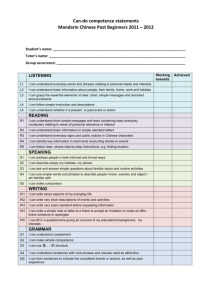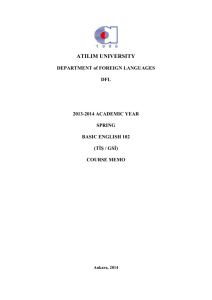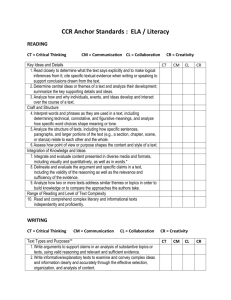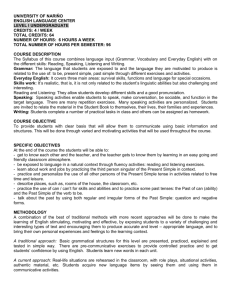Level 600
advertisement
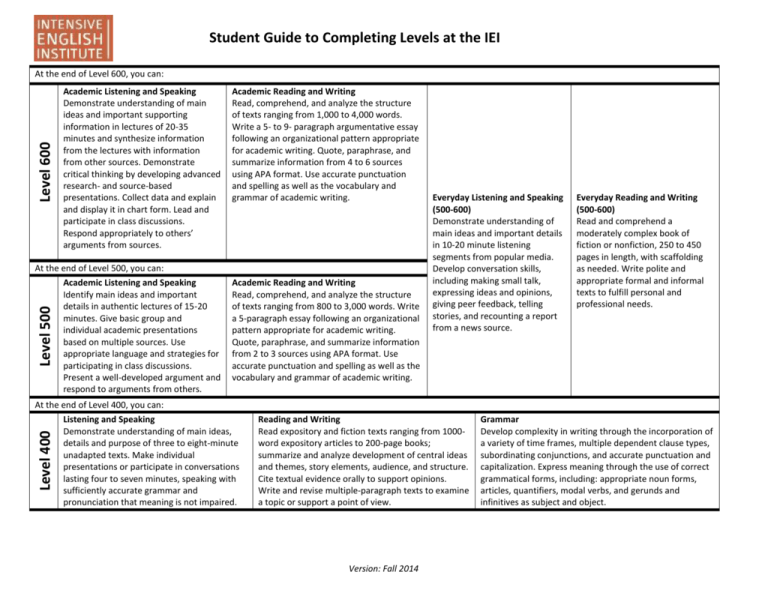
Student Guide to Completing Levels at the IEI Level 600 At the end of Level 600, you can: Academic Listening and Speaking Demonstrate understanding of main ideas and important supporting information in lectures of 20-35 minutes and synthesize information from the lectures with information from other sources. Demonstrate critical thinking by developing advanced research- and source-based presentations. Collect data and explain and display it in chart form. Lead and participate in class discussions. Respond appropriately to others’ arguments from sources. Academic Reading and Writing Read, comprehend, and analyze the structure of texts ranging from 1,000 to 4,000 words. Write a 5- to 9- paragraph argumentative essay following an organizational pattern appropriate for academic writing. Quote, paraphrase, and summarize information from 4 to 6 sources using APA format. Use accurate punctuation and spelling as well as the vocabulary and grammar of academic writing. Level 500 At the end of Level 500, you can: Academic Listening and Speaking Identify main ideas and important details in authentic lectures of 15-20 minutes. Give basic group and individual academic presentations based on multiple sources. Use appropriate language and strategies for participating in class discussions. Present a well-developed argument and respond to arguments from others. Academic Reading and Writing Read, comprehend, and analyze the structure of texts ranging from 800 to 3,000 words. Write a 5-paragraph essay following an organizational pattern appropriate for academic writing. Quote, paraphrase, and summarize information from 2 to 3 sources using APA format. Use accurate punctuation and spelling as well as the vocabulary and grammar of academic writing. Everyday Listening and Speaking (500-600) Demonstrate understanding of main ideas and important details in 10-20 minute listening segments from popular media. Develop conversation skills, including making small talk, expressing ideas and opinions, giving peer feedback, telling stories, and recounting a report from a news source. Everyday Reading and Writing (500-600) Read and comprehend a moderately complex book of fiction or nonfiction, 250 to 450 pages in length, with scaffolding as needed. Write polite and appropriate formal and informal texts to fulfill personal and professional needs. Level 400 At the end of Level 400, you can: Listening and Speaking Demonstrate understanding of main ideas, details and purpose of three to eight-minute unadapted texts. Make individual presentations or participate in conversations lasting four to seven minutes, speaking with sufficiently accurate grammar and pronunciation that meaning is not impaired. Reading and Writing Read expository and fiction texts ranging from 1000word expository articles to 200-page books; summarize and analyze development of central ideas and themes, story elements, audience, and structure. Cite textual evidence orally to support opinions. Write and revise multiple-paragraph texts to examine a topic or support a point of view. Version: Fall 2014 Grammar Develop complexity in writing through the incorporation of a variety of time frames, multiple dependent clause types, subordinating conjunctions, and accurate punctuation and capitalization. Express meaning through the use of correct grammatical forms, including: appropriate noun forms, articles, quantifiers, modal verbs, and gerunds and infinitives as subject and object. Student Guide to Completing Levels at the IEI Level 300 At the end of Level 300, you can: Listening and Speaking / Pronunciation Demonstrate an understanding of a speaker’s attitude and position in spoken language with fairly complex relationships between facts, people, and ideas. Maintain a two-to-three minute conversation about familiar or unfamiliar situations and make a six- to eight-minute presentation about a personal experience or social situation. Produce accurate stress, intonation, and rhythm in controlled practice tasks. Reading Identify topics, main ideas, and supporting details in texts of eight to ten paragraphs (700 to 1000 words) with indirectly stated main ideas, “buried” topic sentences, and qualified points of view. Understand and recognize vocabulary on common topics. Use vocabulary strategies such as recognizing various types of context and word part clues. Demonstrate the ability to process more abstract pronoun references. Writing Write and revise single paragraphs to examine a topic or support a point of view using personal experience. Use simple, compound, and basic complex sentences. Capitalize, punctuate, and spell accurately. Grammar Write sentences with increasingly complex grammatical structures in less structured tasks. Demonstrate the ability to use parallel structures, common transitions, direct and indirect speech in written work with increasing accuracy. Reading Identify topics, main ideas, and supporting details in straightforward, single-topic texts of five to seven paragraphs and 600 to 800 words. Recognize and use vocabulary relating to texts studied in class. Make reasonable guesses about the meanings of clearly contextualized words. Demonstrate the ability to process concrete pronoun references (it, she, he, they). Grammar Write basic compound and complex sentences using simple verbs in past, present, and future tenses as well as progressive verbs in past and present tenses. Write with an increasing number of modals for everyday functions. Improve accuracy in use of noun forms, quantifiers, and comparative and superlative forms. Pronunciation Perceive and produce English vowel, consonant, and ending sounds in controlled and semicontrolled tasks. Explain how and why to produce English with natural rhythm, stress, and intonation. Predict and produce rhythm, stress placement, and intonation patterns in controlled tasks. Perceive and produce stress patterns in familiar words and compound nouns. Reading Identify topics and supporting details in simple texts of four to six paragraphs and 500 to 700 words. Recognize and use vocabulary of everyday life. Recognize simple pronoun references for concrete noun phrases. Grammar Write simple sentences in the correct order using simple past and present verbs, present progressive verbs, and some modal verbs. Use correct pronouns as well as the simplest and most frequent determiners in writing. Pronunciation Perceive and produce English vowel, consonant, -s, and -ed ending sounds in controlled speaking/listening tasks. Identify and produce stressed and reduced syllables in familiar words and numbers. Predict and produce English rhythm, including trimming and blending. Level 200 At the end of Level 200, you can: Listening and Speaking Demonstrate an understanding of the speaker’s attitude and basic relationships between facts, people, and ideas. Understand and use conversational English in many everyday situations. Explain personal and routine experiences in planned speaking tasks. Use some compound and complex sentences appropriate for the situation. Level 100 At the end of Level 100, you can: Listening and Speaking Demonstrate understanding of main ideas and details in adapted texts on familiar everyday topics. Participate in simple conversations; give short presentations about yourself, family and everyday life. Use simple grammatical patterns and basic everyday vocabulary. Version: Fall 2014





